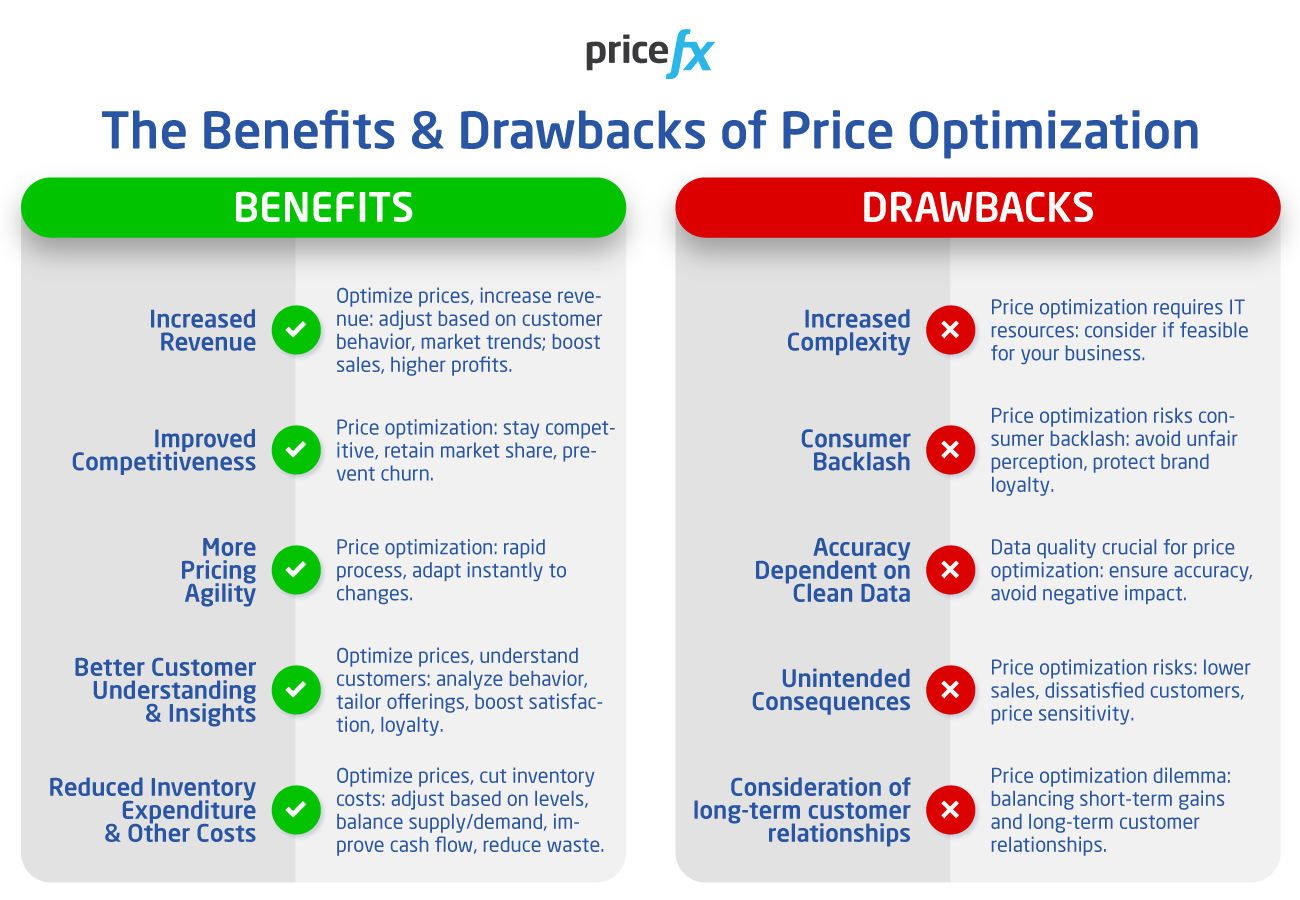Optimizing your prices with the goal of finding the right balance between pricing your products or services to achieve your company’s overarching goals and objectives should be a slam dunk full of benefits and without any drawbacks to speak of, right? Well, yes and no. It all might come down to your company’s size, sector, and complexity. Most of you (particularly those in larger enterprise-level organizations) will find plenty of benefit in price optimization, but for some smaller and less complicated businesses, applying the technology could be too much to take on. That is exactly why we decided to clarify the situation once and for all as we discuss the benefits and drawbacks of price optimization in this article.
At Pricefx over the last decade and more, we have helped hundreds of clients with the art of not leaving money on the table and assisted them in building profitability and streamlining business efficiencies across their organizations. Our clients benefit from optimized pricing seamlessly fed into their internal systems to elegantly supply the right price – to the right person – for the right product – at the right time.
As much as the benefits of fine-tuning your pricing for each product and customer segment and according to your customer’s willingness to pay sound great, there may be drawbacks to price optimization that you might not have considered. We will examine all the benefits and drawbacks of price optimization in this article to arm yourself with all the information you need to decide if it is right for your business or not. However, straight out of the gates, let’s define exactly what price optimization is.
Price Optimization – The Definition

Price optimization is a pricing technique that aims to find the ideal pocket price for a product or service that maximizes profits or whatever else your overarching business objectives might be. While maximizing profit is the most common business goal of price optimization, there are several other objectives that you can seek to achieved through its use including:
- Increasing market share: Price optimization can help your business gain a larger market share by setting prices lower than your competitors. This can attract price-sensitive customers who are looking for the best deal, leading to increased sales volume and a larger customer base.
- Improving customer loyalty: By setting prices based on customer preferences and behaviors, organizations can create more personalized pricing strategies that appeal to specific customer segments. This can increase customer satisfaction and loyalty, leading to repeat business and positive word-of-mouth marketing.
- Introducing new products: Price optimization can help your business in introducing new products to the market by setting prices that are attractive to early adopters and influencers. This can generate buzz and momentum around the new product, leading to increased sales for your products and bumping market share.
- Meeting sustainability goals: Price optimization can assist your business to achieve your sustainability goals by setting prices that reflect the true costs of production and distribution, including environmental and social costs. This can encourage more sustainable practices and support the transition to a more sustainable economy.
As you can see, price optimization can be a powerful tool for achieving a range of business objectives beyond maximizing profit. As a result, you can include all the above in your first batch of benefits of a price optimization solution.
However, let’s drill down a little further and look at some more benefits of what price optimization has to offer for your business.

More Potential Benefits of Price Optimization
A well-executed price optimization strategy can potentially help businesses achieve a range of additional benefits to the above, including:
- Increased Revenue: One of the most obvious benefits of price optimization is that it can increase revenue. By adjusting prices based on customer behavior, market trends, and other factors, companies can increase the price of items that are in high demand and decrease the price of items that are not selling well. This can lead to increased sales and higher profits.
- Improved Competitiveness: Price optimization can also help companies to stay competitive. By adjusting prices based on market trends and competitor pricing, companies can ensure that their prices are in line with industry standards. This can help to prevent customers from shopping around for better deals and can help companies to maintain their market share.
- More Pricing Agility: Price optimization takes a pricing process that can take weeks or months and compresses it down into as little as days or hours. When internal or external factors change affecting your pricing, you can instantly react on the fly.
- Better Customer Understanding & Insights: Price optimization allows companies to better understand their customers. By analyzing customer behavior and purchasing patterns, companies can determine which products are most popular and adjust prices accordingly. This can help companies to tailor their offerings to meet customer needs and preferences, which can lead to increased customer satisfaction and loyalty.
- Reduced Inventory Expenditure & Other Costs: Price optimization can also help companies to reduce their inventory costs. By adjusting prices based on inventory levels, companies can lower prices during slow periods and increase prices during peak periods, your organization can look towards balancing supply and demand and avoid overstocking or understocking. This can help to improve cash flow and reduce waste. By optimizing prices, businesses can also identify areas where production costs can be reduced, or by recognizing products or services that are not generating sufficient revenue and need to be discontinued.
- Without such software and the optimization that it allows for in your pricing, you would have to either invest significant resources in hiring and training personnel or make infrequent, once-a-year price changes. However, with optimization, you can make data-driven decisions, ensuring that all these factors are considered simultaneously.
The Drawbacks of Price Optimization
On the other side of the coin, many businesses (particularly smaller companies or those without a critical mass of complexity in terms of their customer or product segments) may consider price optimization and the pricing software that powers it to be too costly and cumbersome for their needs. To get a good idea of the how much a quality and insightful pricing software option can cost, check out the handy article below:
Other potential drawbacks of a price optimization and the software that best enable it include;
- Increased Complexity: Price optimization can be too time-consuming to implement and maintain for companies that do not have the available IT staff to get the job done. Some companies may have their IT staff consumed with other tasks and may need to hire specialized personnel to implement and manage price optimization. If your business does not have the opportunity to make a significant investment of time and resources to implement price optimization software, you may need to rethink if it is right for your business or not.
The good news is, however, if you need assistance in implementing price optimization software, and/or getting your pricing strategy in place, an impressive range of partners are available to do those jobs for you. Learn more about the benefits of working together with a pricing software partner in the article below:
- Consumer Backlash: Price optimization can lead to consumer backlash, especially if the changes in price are perceived as unfair or discriminatory. Customers may feel that they are being taken advantage of or manipulated, which can damage brand reputation and result in a loss of customer loyalty.
- Accuracy Dependent on Clean Data: While price optimization software can provide powerful insights into optimal pricing strategies, the accuracy of the results may be limited by the quality of the data input into the system. The better your data quality, the better and more insightful the results. If you are unsure, or again, have limited IT resources to ensure the quality of your data, price optimization may not yet be right for your business. In fact, if given poor data, an optimization model might have a negative impact on your business because it’s assuming outliers can be modelled for, when realistically, they cannot.
- Unintended Consequences: Price optimization can have unintended consequences, such as reduced sales volume, decreased customer satisfaction, and increased price sensitivity. For example, if a company raises prices too high, it may discourage customers from buying the product or service, leading to a decrease in sales volume. Similarly, if prices are optimized based solely on profitability, it may result in a decrease in customer satisfaction, which can harm the brand reputation.
- Consideration of long-term customer relationships: Another potential drawback of price optimization is that it may prioritize short-term gains over long-term customer relationships. By adjusting prices to maximize profits, businesses may possibly send the message that they prioritize profit over their customers’ satisfaction and loyalty. Of course, it is important for businesses to be proactive and communicate with their clientele while finding a balance between profitability and customer satisfaction.
By carefully considering these drawbacks and developing pricing strategies that prioritize customer satisfaction and ethical behavior, companies can successfully implement price optimization and achieve their business objectives while maintaining a positive brand reputation and strong customer loyalty.
How Do I Know if Price Optimization is Right for my Business?
Now you know the pros and cons of price optimization software and the types of pricing insights and pathways to profits and other business goals that it can provide for companies just like yours.
You may already know if innovative price optimization software like the award-winning Pricefx or similar is something that can help your organization achieve its business objectives, but you would like to dive in a little deeper to make absolutely certain. If that is the case, check out the handy article below for further benefits of price optimization technology, how it works in combination with a total pricing software solution and to drill down into who it is right for, and who may not need it at all.
Or learn more here specifically about Optian, Pricefx’s own price optimization software solution.
Happy Pricing!


